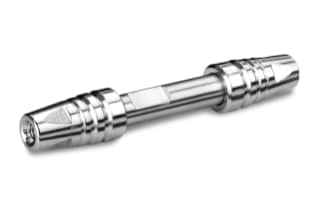
|
Chemistry |
C18 |
|
Separation Mode |
Reversed Phase |
|
Particle Substrate |
Silica |
|
pH Range Min |
2 pH |
|
pH Range Max |
8 pH |
|
Temperature Limits |
45 C |
|
Maximum Pressure |
18000 psi (1240 Bar) |
|
Endcapped |
Yes |
|
Bonding Technology |
T3 |
|
Silanol Activity |
Low |
|
Particle Shape |
Spherical |
|
Particle Size |
2.7 µm |
|
Endfitting Type |
Parker-style |
|
Pore Size |
120 Å |
|
Format |
Column |
|
Surface Area |
100 |
|
System |
UPLC, UHPLC |
|
Particle Technology |
Solid Core |
|
USP Classification |
L1 |
|
Inner Diameter |
4.6 mm |
|
Length |
50 mm |
|
Carbon Load |
4.7 % |
|
UNSPSC |
41115709 |
|
Brand |
CORTECS |
|
Product Type |
Columns |
|
Units per Package |
3 pk |

CORTECS T3 Column, 120Å, 2.7 µm, 4.6 mm X 50 mm, 3/pk
The polarity of specific analytes can create challenges for a liquid chromatographer, but those challenges can be overcome easily with the CORTECS T3 Column. Thanks to the T3 column chemistry and C18 surface concentration, you’re able to operate with 100% aqueous mobile phases with little concern for MS bleed or losses in signal intensity. But that’s not the only benefit to owning this T3 UPLC column. It can also provide you with a long column lifetime and terrific peak shape. This all adds up to an LC-MS product that you can rely on to perform incredibly time and again.
The unique particle morphology for the T3 column chemistry makes this column offer high efficiency and lower back pressure. Just compare it to fully porous particles of the same size and you’ll see that the CORTECS T3 Column is better suited for chromatographic separations with 100% aqueous mobile phases. And if you’re working with non-polar analytes, the CORTECS T3 Column can handle them with ease.
What else does the CORTECS T3 Column have to offer?
For one, it offers greater throughput and speed, which can result in increased business profitability. Waters scientists designed this UPLC column to be used for speed and retention; two facets incredibly important to the scientific community. Also, if you’re using low percentages of organic modifier, that’s not problem. The conventional C18 behavior of this column enables you to use as much or little organic modifier as you want.
To retain polar compounds, scientists everywhere prefer reversed-phase chromatographic conditions. That’s part of why we’ve designed the CORTECS T3 Column to work with reverse-phase chromatography while also being derived from C18 ligands. Reversed-phase retention can be affected negatively by hydrophobic collapse, but this T3 column reduces the risk of that collapse. The bonded alkyl functionality of this column will also help you operate with low-pH compounds.
Need a column that provides alternate selectivity?
Shop CORTECS Columns to find exactly what you need. The CORTECS product line is filled with UPLC columns designed to handle a wide array of different compounds. Even your most difficult samples can be handled by these state-of-the-art columns. And with VanGuard Cartridges available to be added to all CORTECS columns, superior column lifetime is more achievable than ever.
No matter if you’re a lab manager, scientist or mass spectrometry novice, Waters Corporation has the resources you’ll need to perform LC separations that result in reliable data. Shop for lab equipment now. We’re your one-stop shop for all LC-MS equipment.
What is the pH Range of the CORTECS T3 Column?
The CORTECS T3 Column offers a range of 2 to 8 pH.